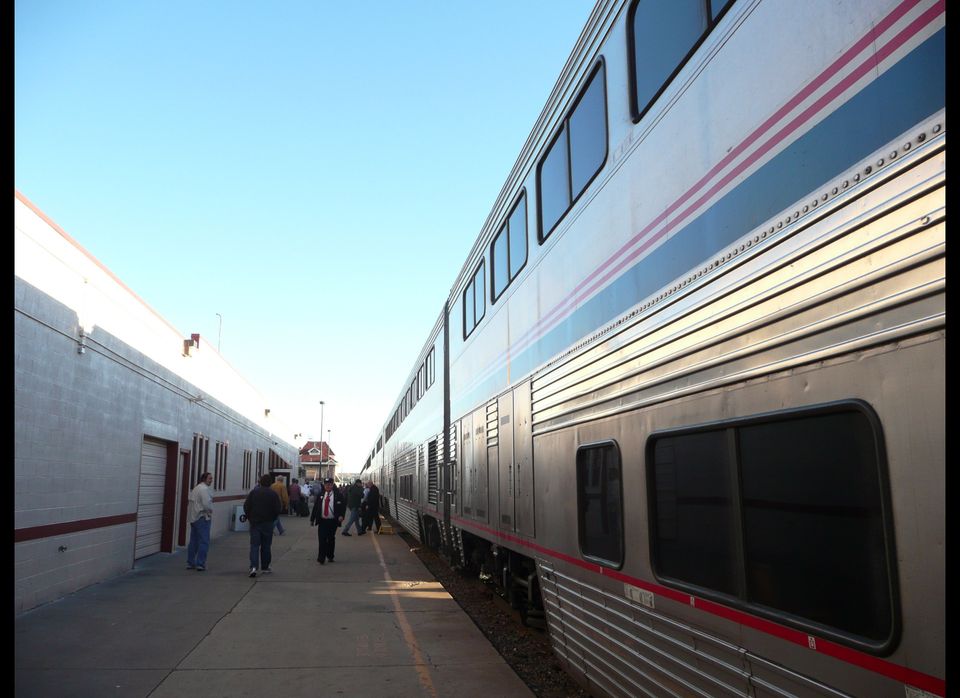I drank in the cafe car on Amtrak's California Zephyr as our train sliced through the wilderness of western Colorado. The late afternoon sun cast its rays across stretches of exposed mountain rock and warmed the rushing Colorado River. A lone cabin slumped between heels then slipped from view as the train's engines pulled us unrelentingly onward.
There are no freeways. No off-ramps. No billboards. Only rarely is there concrete. On Amtrak's great cross-country lines, there are few of the experiences of modernity. Oh, there are occasional power lines casting shadowy threads, but they seem more like they were spun by spiders than built by men. Towns rear up ahead only to melt away into vistas older than anything human.
This is a chance to escape from smallness, a chance to be captured by awe.
All this is simply to say that, for all the manifest deficiencies and embarrassments of American passenger rail, its great virtue likely lies in its ability to introduce one to beauty, acclimating one simultaneously to the mental withdrawal and physical slowness necessary to appreciate that beauty, and to be arrested in its presence.
This is not to speak of Amtrak's Northeast Regional or Acela lines running from Boston to Washington, DC, the routes that are, by a wide margin, their most traveled and also least beautiful, following along through the concrete jungles of our old industrial heart. These are lines that leave you feeling the whole earth has been defaced, where the spectral hideousness of it all induces neither withdrawal into nature nor wonder, but limp subjugation by raw power.
It's a paradox of modernity, speaking in terms of architecture, that the richer we become as a nation, the cheaper and uglier are the structures we tend to create. That what we intuitively appreciate in Georgian, Spanish Colonial or even Art Deco should ever have given way to the self-indulgence and banality of the tower block speaks to a bankruptcy of spirit. Beauty is intuitively felt, and loved, yet man's crafting or preservation of beautiful things also seems to be fleeting.
Beauty may be the means by which Amtrak's nationwide 46-state system can be defended and perhaps justified in the face of the perennial calls to dismantle all but the major city corridors.
The perverse irony of our time is that Amtrak's $1 billion annual fiscal shortcomings no longer seem so great. But if the inclination of the politician bears out, of dealing with smaller problems while avoiding structural challenges, Amtrak's unprofitable but stupendously beautiful lines, like the Chicago to Los Angeles California Zephyr or the Seattle to Chicago Empire Builder or the City of New Orleans could disappear.
But government tends to do so little right that when it accidentally does something good, like preserving the legendary passenger rail lines forged by the early 20th century business titans, perhaps it's worth trying to save.
By speaking of beauty and, really, the social utility of isolation afforded by rail in relation to highways or airlines, we can conceive of American passenger rail as having worth in a much different sense. We can measure it differently than by its point-to-point efficiency, where it tends not to excel, but by its access to the wondrous, where it is priceless.
None of this is to justify Amtrak per se, or the excesses of its system which lay in the notion that our national ego would be damaged by a slimming of habitually underpopulated service routes. The California Zephyr presents a spiritually powerful experience, but it would not be a sin for the line to run three days each week rather than seven.
Amtrak as a government enterprise may be, and is indeed likely, unredeemable in that its structure and culture are enmeshed with its deficiencies, losses and subservience to its service union. But its presentation of unspoiled beauty, its encounter with the divine, is a real virtue -- a national treasure -- despite everything else. And this is a treasure, a virtue, tied to the means of rail travel and not to the medium of the National Passenger Rail Corporation.
It's difficult to conceive of Amtrak as we know it surviving the fiscal austerity that lies ahead. If it's true that beauty will save us, there's also reason to hope that at least a few of the old lines it has preserved survive as gifts to future generations.
